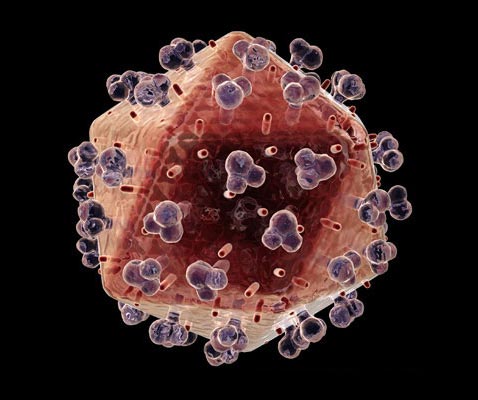Detecting new antibodies to prevent transmission of HIV
Scientists at Duke University Medical Center (USA) have discovered two antibodies 2F5 and 4E10 have mechanisms to prevent transmission of HIV.
This finding opens new directions for the preparation of vaccines that effectively prevent HIV transmission.
Dr. Munir Alam of the vaccine research lab at Duke University Medical Center and Professor Chenbing of Harvard Medical Institute collaborated to study two antibodies 2F5 and 4E10.

HIV virus.Photo: purselipsquarejaw.org
HIV has a critical weakness that is the area near the outer membrane. Meanwhile, the protein layer in this area will be temporarily released during viral transmission and cell tolerance, thereby forcing HIV to reveal before antibodies in a few minutes. Antibodies 2F5 and 4E10 will take advantage of this opportunity to capture the virus and prevent infection.
However, the problem still exists in controlling HIV transmission is that there are very few antibodies in the body of HIV-infected people, and experimental vaccines are still not yet produced. born this antibody.
In addition, Dr. Munir Alam said that the target area of HIV appears only for 15 minutes or even shorter. Unless antibodies reach very close to the target area and do well in preparation, otherwise they will not work. This means creating a new vaccine that can produce many of these antibodies.
Both of the above resistance have a very long protein structure so it is easily absorbed by Lipid. Scientists found that antibodies that want to successfully reach the weak point of HIV need to penetrate into the outer membrane area of HIV containing the Lipid component.
Researchers have begun the work of preparing a vaccine containing a lipid component. Of all the functions of this antibody, it is the reactive effect of Lipid in the outer HIV membrane that is critical for scientists to develop new vaccines.
Currently scientists have begun conducting experiments on animals.
- Immune antibodies before HIV
- Identify two antibodies that promise to fight MERS
- Use of cow's milk to prevent HIV
- Cloning pigs without antibodies for human organ transplantation
- Thailand - the first country in Asia to prevent HIV transmission from mother to child
- Cuba - The first country to successfully prevent mother-to-child transmission of HIV
- False nipples prevent mother-to-child transmission of HIV
- Detects antibodies against many types of flu
- Detecting compound 'lock' is HIV virus
- Next-generation antibiotics can use light to
- In what ways is HIV transmitted?
- Present the world's first artificial antibody
 Green tea cleans teeth better than mouthwash?
Green tea cleans teeth better than mouthwash? Death kiss: This is why you should not let anyone kiss your baby's lips
Death kiss: This is why you should not let anyone kiss your baby's lips What is salmonellosis?
What is salmonellosis? Caution should be exercised when using aloe vera through eating and drinking
Caution should be exercised when using aloe vera through eating and drinking